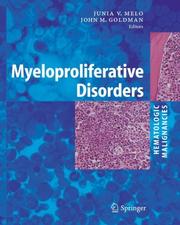| Listing 1 - 1 of 1 |
Sort by
|

ISBN: 9783540345053 9783540345060 Year: 2007 Publisher: Berlin Heidelberg Springer Berlin Heidelberg
Abstract | Keywords | Export | Availability | Bookmark
 Loading...
Loading...Choose an application
- Reference Manager
- EndNote
- RefWorks (Direct export to RefWorks)
. . . To put together such apparently dissimilar diseases as chronic granulocytic leukemia, polycythemia, myeloid metaplasia and diGuglielmos's syndrome may conceivably be without foundation, but for the moment at least, this may prove useful and even productive. What more can one ask of a theory? So ended the editorial entitled Some Speculations on the Myeloproliferative Syndomes published in Blood in 1951 by the journal editor, William Dameshek. He speculated that these various conditions, which he had termed myeloproliferative, were all somewhat variable manifestations of proliferative activity of the bone marrow cells, perhaps due to a hitherto undiscovered stimulus. More than half a century later, Dameshek would probably have been pleased to learn that much has been learned about the cellular defects that cause these various disorders and that the term he coined has survived more or less intact. True, research focuses today as much on genetic abnormalities intrinsic in the clonal populations as on the dysregulation of cytokines or other stimulatory factors that contribute to f- tures of these different diseases. However, in general his grouping of seemingly disparate diseases has stood the test of time. Chronic granulocytic leukemia has been renamed chronic myeloid leukemia or chronic myelogenous leukemia, and myeloid metaplasia is now idiopathic myelofibrosis - semantics only.
| Listing 1 - 1 of 1 |
Sort by
|

 Search
Search Feedback
Feedback About UniCat
About UniCat  Help
Help News
News